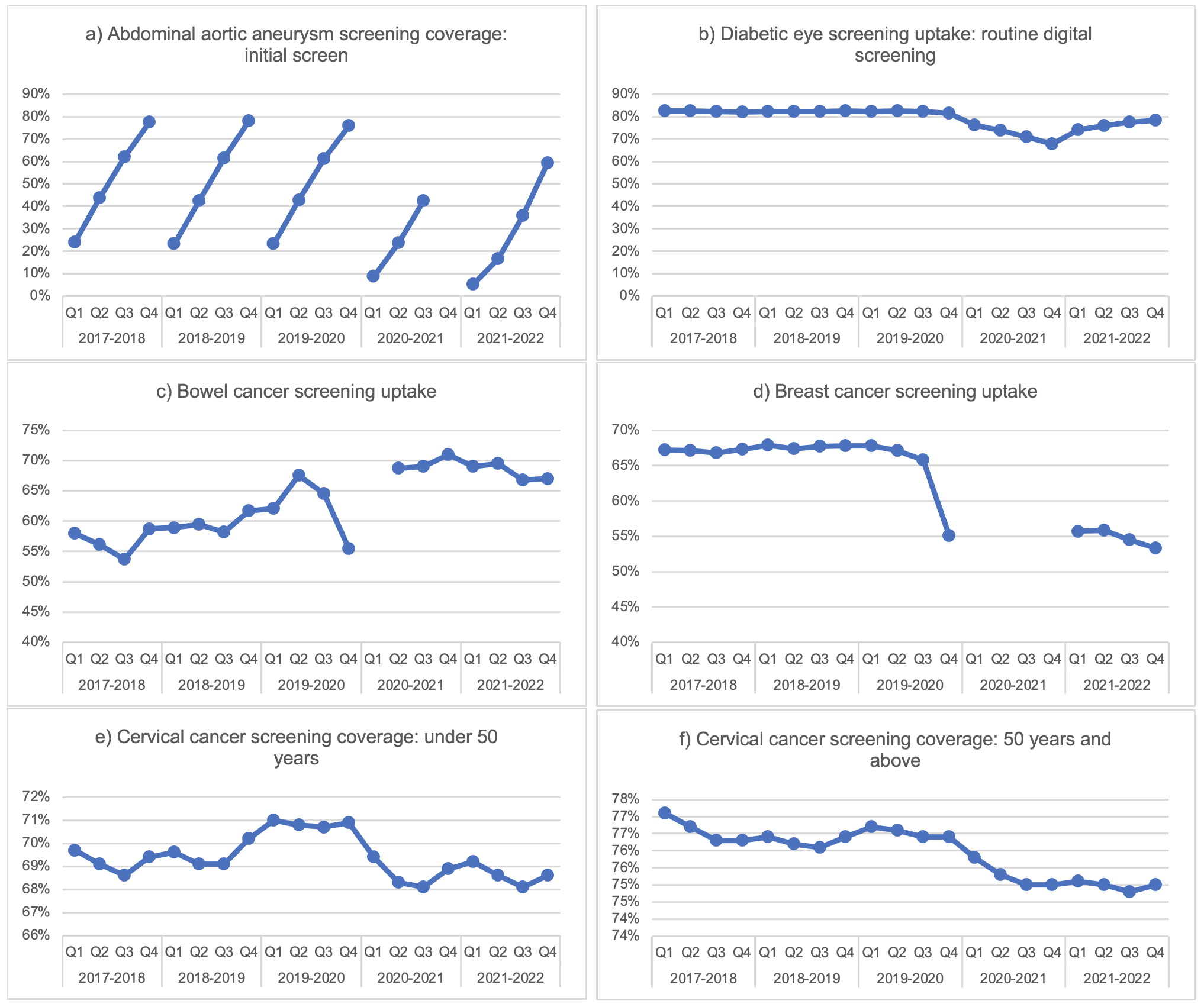 Richard Armitage is a GP and Public Health Specialty Registrar, and Honorary Assistant Professor at the University of Nottingham’s Academic Unit of Population and Lifespan Sciences. He is on twitter: @drricharmitage
Richard Armitage is a GP and Public Health Specialty Registrar, and Honorary Assistant Professor at the University of Nottingham’s Academic Unit of Population and Lifespan Sciences. He is on twitter: @drricharmitage
Five national screening programmes are in operation across England for adults — abdominal aortic aneurysm (AAA) screening, diabetic eye screening, bowel cancer screening, breast screening, and cervical screening1 — and primary care is essential to the direct delivery or active promotion of many of these.2
The performances of all these screening programmes were substantially reduced by the arrival of the COVID-19 pandemic in March 2020. Only bowel cancer screening — the single screening programme that requires in-person attendance — had recovered to its pre-pandemic level by 2020–2021 Quarter (Q)2,3 which is likely explained by the temporary suspension of screening programmes during the first COVID-19 national lockdown in England, and the inability or unwillingness of invitees to partake once in-person programmes recommenced.
Two further national COVID-19 lockdowns and various localised restrictions on social contact were imposed after 2020–2021 Q3.4 Unlike the first national lockdown, however, screening programmes were not suspended during these subsequent restrictions. All limitations on social contact were removed in England on, and not reinstated after, 19 July 2021.4
The impact on screening programme performance must be tracked as the pandemic progresses so that appropriate remedial action can be taken. Publicly available data pertaining to the national screening programmes can be used to analyse performance trends from 2017-2018 Q1 to 2021-2022 Q4 (incorporating all available data, ending 31 March 2022, see Figure 1 and Table 1).5,6

| Table 1. Data pertaining to coverage/uptake of five national screening programmes in England from 2017–20225,6 | |||||||
| Cervical screening coverage, % | |||||||
| Year and quarter | AAA screening (initial screen), % | Diabetic eye screening uptake, % | Bowel cancer screening uptake, % | Breast screening uptake, % | Aged <50 years | Aged ≥50 years | |
| 2017–2018 | Q1 | 23.9 | 82.7 | 58.0 | 67.2 | 69.7 | 77.1 |
| Q2 | 43.9 | 82.5 | 56.1 | 67.1 | 69.1 | 76.7 | |
| Q3 | 62.1 | 82.3 | 53.7 | 66.8 | 68.6 | 76.3 | |
| Q4 | 77.6 | 82.0 | 58.7 | 67.3 | 69.4 | 76.3 | |
| 2018–2019 | Q1 | 23.2 | 82.3 | 58.9 | 67.9 | 69.6 | 76.4 |
| Q2 | 42.6 | 82.3 | 59.4 | 67.4 | 69.1 | 76.2 | |
| Q3 | 61.6 | 82.4 | 58.2 | 67.7 | 69.1 | 76.1 | |
| Q4 | 78.0 | 82.6 | 61.7 | 67.8 | 70.2 | 76.4 | |
| 2019–2020 | Q1 | 23.1 | 82.2 | 62.1 | 67.8 | 71.0 | 76.7 |
| Q2 | 42.7 | 82.5 | 67.5 | 67.1 | 70.8 | 76.6 | |
| Q3 | 61.3 | 82.3 | 64.5 | 65.8 | 70.7 | 76.4 | |
| Q4 | 76.1 | 81.5 | 55.4 | 55.1 | 70.9 | 76.4 | |
| 2020–2021 | Q1 | 8.8 | 76.3 | — | — | 69.4 | 75.8 |
| Q2 | 23.7 | 73.8 | 68.7 | — | 68.3 | 75.3 | |
| Q3 | 42.4 | 70.9 | 69.0 | — | 68.1 | 75.0 | |
| Q4 | — | 67.9 | 71.0 | — | 68.9 | 75.0 | |
| 2021–2022 | Q1 | 5.3 | 74.1 | 69.0 | 55.7 | 69.2 | 75.1 |
| Q2 | 16.5 | 76.1 | 69.5 | 55.8 | 68.6 | 75.0 | |
| Q3 | 35.9 | 77.6 | 66.8 | 54.5 | 68.1 | 74.8 | |
| Q4 | 59.5 | 78.4 | 67.0 | 53.3 | 68.6 | 75.0 | |
| AAA = abdominal aortic aneurysm. Q = quarter. | |||||||
AAA screening coverage (initial screen). Annual (Q4) performances prior to 2020–2021 ranged from 76.1% to 78.0%, but declined to 42.4% in 2020–2021 Q3 (2020–2021 Q4 data are unavailable, but 2020–2021 Q3 data are substantially lower than the corresponding 2017–2018, 2018–2019, and 2019–2020 Q3 data) and 59.5% in 2021–2022 Q4.
Diabetic eye screening uptake (routine digital screening). Quarterly performances prior to 2019–2020 Q4 ranged from 82.0% to 82.7%, but declined to 67.9% in 2020–2021 Q4. Performance subsequently improved throughout 2021–2022 to 78.4% in Q4.
Bowel cancer screening uptake. Performance declined in 2019–2020 Q4, but had normalised by 2020–2021 Q2 and remained stable throughout 2021–2022.
Breast cancer screening uptake. Quarterly performances prior to 2019–2020 Q4 ranged from 65.8% to 67.9%, but declined to 55.1% in 2019–2020 Q4. No data were available for 2020–2021. Performance continued to decline throughout 2021–2022 to 53.3% in 2021–2022 Q4.
“Remedial action is urgently required, especially with regard to breast cancer screening … “
Cervical cancer screening coverage. Quarterly performance for 2019-2020 in those aged <50 years ranged from 70.7% to 71.0%, but declined to 68.1% in 2020–2021 Q3. Performance remained stable throughout 2021–2022. Quarterly performance for 2019-2020 in those aged ≥50 years ranged from 76.4% to 76.7%, but declined to 75.0% in 2020–2021 Q4. Performance remained stable throughout 2021–2022 (75.0% in 2021–2022 Q4).
In summary, by the end of 2021–2022 Q4: bowel cancer screening uptake had recovered to its pre-pandemic performance; diabetic eye screening uptake had partially recovered, but had not regained its pre-pandemic performance; AAA screening coverage (annual performance) remained substantially below its pre-pandemic performance; cervical cancer screening coverage in both those aged <50 and ≥50 years had not recovered at all, but remained stable; and breast cancer screening uptake had not recovered at all, and was worsening.
The national screening programmes were not repeatedly suspended following the initial lockdown, and 8 months had elapsed between the removal of all social contact limitations and the final Q of data included in this analysis. This provided the potential for the performance of the four in-person national screening programmes (all other than bowel cancer screening) to recover to their pre-pandemic levels. However, this was only achieved in bowel cancer screening coverage.
While the underlying mechanisms for these differences in performance recovery are unclear, COVID-19 continued to have substantial impacts on screening performances in England until at least the end of 2021–2022 Q4 (most recent data available). The performance of breast cancer screening, which is the only programme that continues to deteriorate (all others have recovered entirely, are recovering, or are stable), is the most concerning. Remedial action is urgently required, especially with regard to breast cancer screening, including enhanced screening capacity and persuasive health promotion from both primary care practitioners and public health professionals that targets those eligible for diabetic eye screening, AAA screening, and cervical cancer screening, but especially breast cancer screening.
References
1. NHS. NHS Screening. 2021. https://www.nhs.uk/conditions/nhs-screening (accessed 18 Nov 2022).
2. Modi RN, Kelly S, Hoare S, et al. Delivering screening programmes in primary care: protocol for a scoping and systematic mixed studies review. BMJ Open 2021; 11(4): e046331.
3. Armitage RC, Morling JR. The impact of COVID-19 on national screening programmes in England. Public Health 2021; 198: 174–176.
4. Institute for Government Analysis. Timeline of UK government coronavirus lockdowns and measures, March 2020 to December 2021. https://www.instituteforgovernment.org.uk/sites/default/files/chart-images/timeline-coronavirus-lockdown-december-2021_0.png (accessed 18 Nov 2022).
5. NHS England. Young person and adult screening KPI data: Q4 summary factsheets (1 January to 31 March 2022). 2022. https://www.gov.uk/government/publications/nhs-screening-programmes-kpi-reports-2021-to-2022/young-person-and-adult-screening-kpi-data-q4-summary-factsheets-1-january-to-31-march-2022 (accessed 18 Nov 2022).
6. NHS England. Young person and adult screening KPI data: Q4 summary factsheets. 2022. https://www.gov.uk/government/publications/nhs-screening-programmes-kpi-reports-2020-to-2021/young-person-and-adult-screening-kpi-data-q4-summary-factsheets (accessed 23 Nov 2022).
Featured photo (cells from cervical cancer) by National Cancer Institute on Unsplash.






